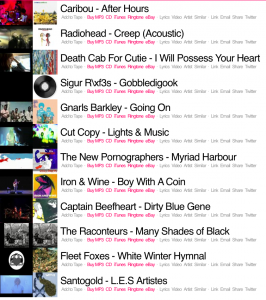After my first gee-whiz-I-love-nostalgia post, I had some further thoughts on MTV’s new music video archive site.
First, these kind of sites are are a bittersweet evolution, and in a sense, a compromise. While it is fantastic to see MTV pushing the music industry forward to a point where they’re offering content openly and gratis, the features of MTVM are simply not robust enough to sustain the long term health of our media environment.
MTV will still remain the gatekeeper of culture as they did as a television station — there’s no ability to upload your own videos to their network and the most interaction users have with the community is to add comments. There’s no ability to download the videos for remix (they’re also encumbered by Adobe flash) and the site seems to be generally lacking in the read-write attitude embraced by YouTube and other video platforms.
The web is a conversation, and with the success of sites like Seesmic, its clear that video can be as well.
The massive popular acceptance of sites like MTVM and Hulu, is compromising the natural interactive nature of the web for the sake of ease and passive consumerism. Where I like to think of the projects I’m involved in as breaking down the definition between consumer and producer, there’s a very real chance that popular culture will not want to put out the effort to create their own culture and simply continue to passively consume the work of others.
We’ve seen participatory lose out to passive before. When public access television was initially conceived and implemented, a lot of media scholars spoke to potential of the cheap and easy nature of video to bring down the gatekeepers of traditional media conglomerates.
Almost 30 years later, Public Access Television is pretty much a farm league for amateurs looking to get a start in the traditional television market. It is, not, as its early advocates predicted, a utopia of participatory culture that competes and challenges mainstream media.
Now, however, participatory media has achieved a significant lead on the web. YouTube has massively popular stars that created their own fame and content from their bedroom, and Wikipedia has reached an extraordinary level of cultural significance. Indeed, most of the big sites on the web are participatory — eBay, Craigslist, Google, or any blog platform. But we risk abdicating this leadership position by not challenging MTVM and NBC to open their network and content even further. In other words, keep the pressure on. Ask why the MTVM videos aren’t available for download, and then, why aren’t they Creative Commons licensed?
To some extent we’ve asked for this problem. Throughout the decade old debate over file sharing, a popular proposed solution to the lawsuits was for the content owners to simply offer free (or cheap) useful versions of the content fans were already sharing. They could compete with free and unauthorized (p2p) simply by offering easy and authorized. AmazonMP3, iTunes, and now Hulu all demonstrate that this solution works to some extent.
But I don’t think we can be satisfied with simply watching TV on the web, and we should do all that we can to keep the tables tilted in favor of participatory media rather than passive.
Second, can someone please make a “Be Your Own VJ” drag n’ drop playlist app with MTV’s API that will allow me to create an 1 hour of non-stop awesomeness? I’d love to have a little standalone page that just recreates the heyday of MTV minus the VJs. Basically, just MuxTape for videos. I’m going to start hacking a version of OpenTape to work with MTV’s API, but I’d love it if someone could beat me to the punch.
Third, does anyone think that the title “MTV Music” is ridiculously redundant? Music Television Music. Riiight.












